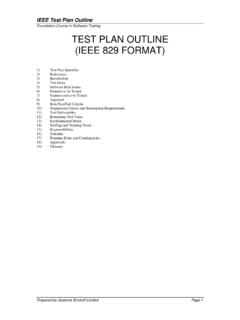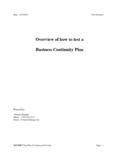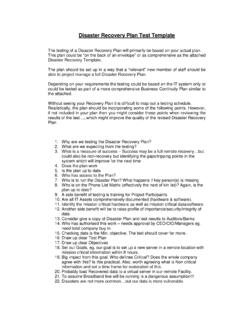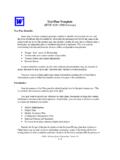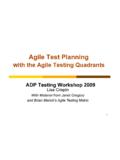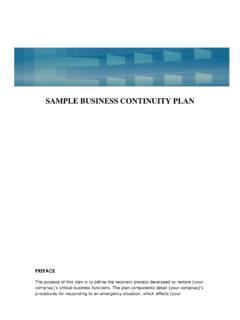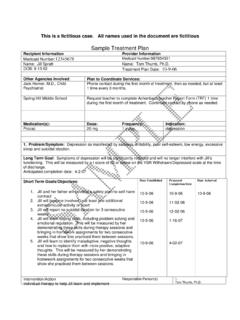Transcription of SYSTEM TEST PLAN and PEOPLESOFT FMS TEST SCRIPTS - …
1 ERP Test plan Revised 7/5/10 Copyright 2010 SpearMC Consulting Page 1 of 15 SYSTEM TEST plan and PEOPLESOFT FMS TEST SCRIPTS ERP Test plan Revised 7/5/10 Copyright 2010 SpearMC Consulting Page 2 of 15 INTRODUCTION The Oracle Implementation project team will implement Oracle applications package at client site. The intent of this document is twofold: To provide the reader with an understanding of the testing strategy that will be used to ensure that the executable SYSTEM performs as required; and To identify resource requirements to ensure adequate staffing levels are available to conduct testing activities. SCOPE & OBJECTIVES The testing strategy specified in this document addresses integrated SYSTEM testing (including file conversions, interfaces, online processing, and daily and monthly processing), functional testing and user acceptance testing.
2 Unit testing of each program is the responsibility of the developer and is outside the scope of this document. Unit testing is defined as the programmer verifying that the output can be successfully processed by the receiving SYSTEM . All the Data Conversion programs have been written and programmed by SpearMC Consulting, Inc. The purpose of this SYSTEM test is to determine the adequacy of the Oracle SYSTEM software for carrying out those tasks comprising the business functions pertaining to or related to a replacement of the legacy systems. The following section summarizes the scope and objectives associated with each type of testing which will be conducted for the Project. Conversion Testing - Conversion testing verifies that historical balance data and current year transaction data has been converted correctly.
3 The following summarizes the conversions that will be converted to the GL: Current year transaction history Five years of history actual and average balances One year of actual balances statistical accounts Interface Testing - Interface testing verifies that all systems that feed the General Ledger SYSTEM are posting correctly and that all files to be produced from the general ledger SYSTEM are properly formatted. The following interfaces to the GL and extracts from the GL will be tested: All application systems Recreation of Old GL file required for reconciliation ERP Test plan Revised 7/5/10 Copyright 2010 SpearMC Consulting Page 3 of 15 Background Currently testing execution of user module test cases.
4 Client is working through our 1st CRP tests . These unit test plans were written by the SpearMC Consulting, Inc. and test the functionality and usability of the appropriate modules. Formal testing, test cases and test problem reports are being maintained and documented in eProjectWeb. These are then forwarded to the project team requesting a due date for each set of incident fixes. Fixes to these Incidents will be regression tested before the SYSTEM test begins. Document Structure This document includes: A summary of the testing strategy including lists of deliverable s and functional requirements to be tested, a high-level work plan and testing procedures. Detailed descriptions of the test cases to be executed. Test execution information, including test steps and test data to be used.
5 ERP Test plan Revised 7/5/10 Copyright 2010 SpearMC Consulting Page 4 of 15 TESTING STRATEGY Several items will be developed to facilitate testing. A detailed test plan will be developed to document the scope, approach, resources and scheduling of each area that will be tested. The development of test plans will require input from members of the testing team, Finance management and members from the project team. Test plans will be developed for each of the test types described in the previous section. Detailed testing documentation provides several benefits including improved facilitation of technical tasks, communication and structure for organizing, scheduling and managing the testing phase. In addition to the test plans, test case specifications and test results summaries will be developed.
6 The purpose and proposed deliverable outline of each testing deliverable is outlined below. Requirements Hierarchy/Validation Matrix The following Matrix is used to ensure completeness of the SYSTEM Test. Each subsystem is listed below. When a subsystem has been tested it is checked off . This matrix may be subsequently expanded to include the lower level requirement components of each subsystem. When the testing of a low level component is complete the entry on this matrix is likewise checked off . Subsystems Tested New Customers Credit Collections Accounts Receivable Accounts Receivable Reporting Lock Box /Check Application Maintainable Lock Box Shipping Automatic Shipments Limits Substitutions Order Entry Daily Remittances Route Reconciliation Taxes EDI Special Billing ERP Test plan Revised 7/5/10 Copyright 2010 SpearMC Consulting Page 5 of 15 Test plan Purpose: A test plan provides a framework for testing and describes the scope, approach, resources and scheduling of testing activities.
7 Deliverable outline: 1. Introduction 2. Test Items - include functions or features that are to be tested. 3. Features - include features that will be and will not be tested. 4. Approach - a brief summary of the method used to conduct testing in each area. 5. Schedule - include activities, tasks, resources, level of effort and timing. 6. Item pass/fail criteria - describe how the tester decides whether the test was/was not successful. 7. Test deliverables - list of testing documents that will be written. 8. Environmental needs - describe the testing environment including requirements for security, space and data. 9. Risks and Contingencies - identify any risks and assumptions in the test plan . 10. Approvals - identify who has to approve and sign off on plans before testing begins.
8 Organization and Responsibilities The test team will consist of the following SpearMC Consulting, Inc. Personnel: Senior Consultant, 100% Senior Consultant 100% Consultant 100% Senior Consultant Testing Practice 20% The test team will also consist of the following client personnel: See appendix A. The success of the SYSTEM test hinges greatly upon the effort and participation of client employees listed in Appendix A. Major Milestones and Target Dates The SYSTEM Test plan -Test Cases will be completed by 9/1/2010 CRP Test Data and expected results will be developed by 10/1/2010 User Acceptance Text Execution will occur 12/1/2010 through 12/15/2010. ERP Test plan Revised 7/5/10 Copyright 2010 SpearMC Consulting Page 6 of 15 Work Breakdown Structure A detailed Work Breakdown plan is found in appendix B.
9 Problem Reporting A Test Problem Report will be entered into the Testing Management Section of eProjectWeb whenever there is a variation between the expected and actual results of a particular test case. Test case expected results are developed by the test team prior to test execution and are documented in the test plan for each subsystem. Variances caused by a software deficiency, specification deficiency or an invalid test scenario. Incidents will vary in their level of severity. This severity level is documented on the incident log. Incidents are cross-referenced to test plan steps that, in turn, are cross-referenced to Requirement Numbers. The following severity codes will be used: Severity 1: Fatal Error, SYSTEM Crashes, corrupts data or precludes subsequent user testing.
10 Severity 2: Incorrect Result, Downstream testing may continue but module is not production ready. Severity 3: Enhancement, or new Requirement Severity 4: Test Error, Test Data, assumptions or conditions are incorrect or not valid A template for the incident log is contained in appendix C. Test Management will also maintain two Additional Logs. These are: Test Cycle Summary Report Test Problems Status Summary The Test Cycle Summary Report relates to information regarding the status of those Incident Reports that have been formally reported to the client. The Incident Status Summary relates to information about Incidents reported across all program modules currently being tested. Both of these reports are used during the user module testing current under way.

